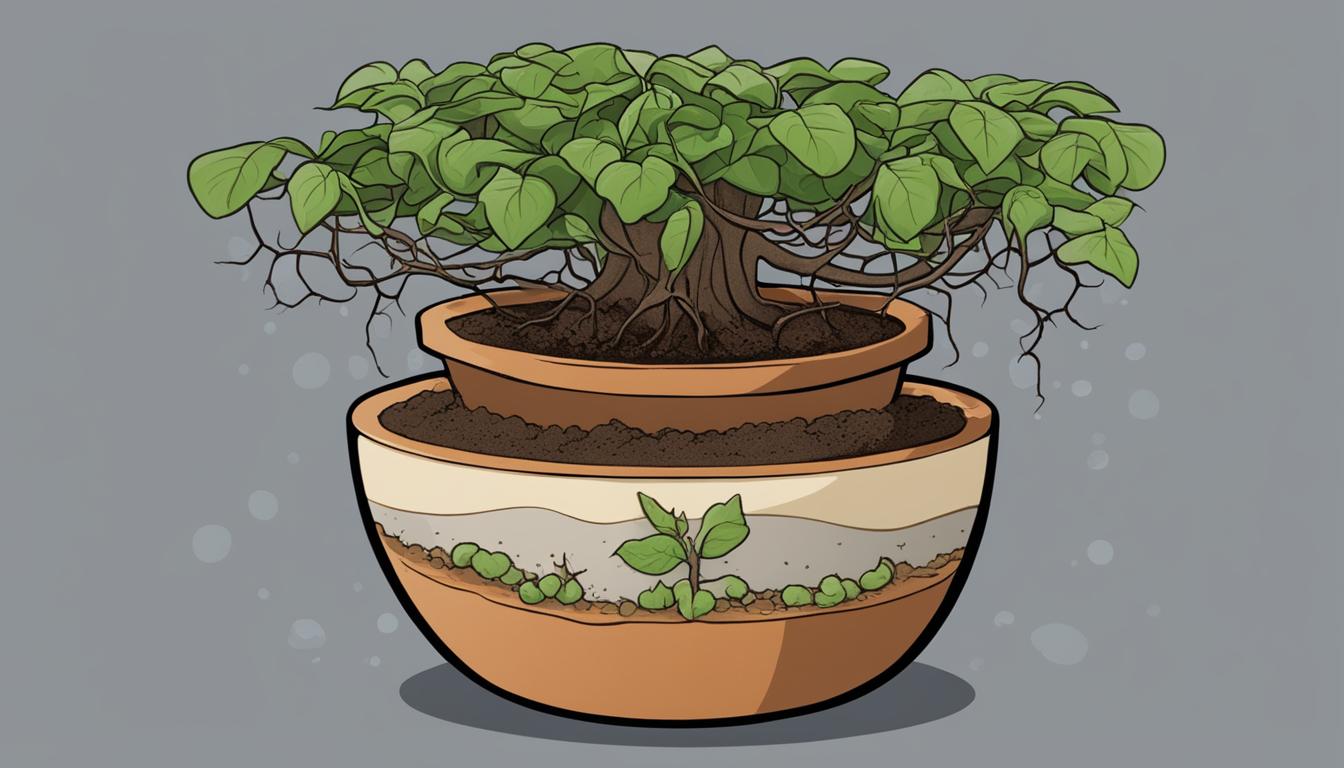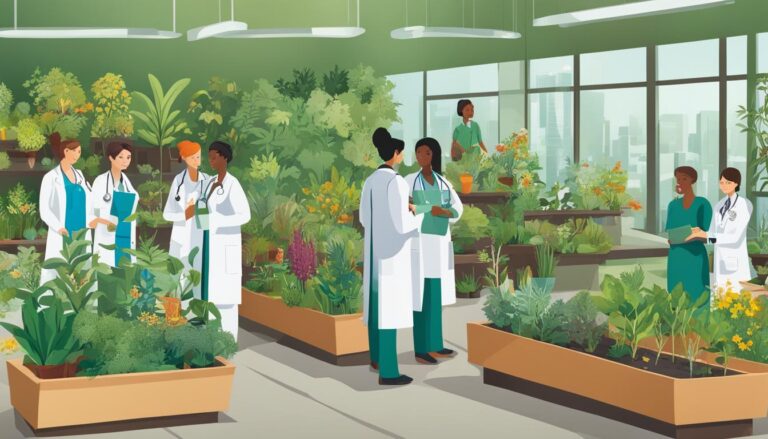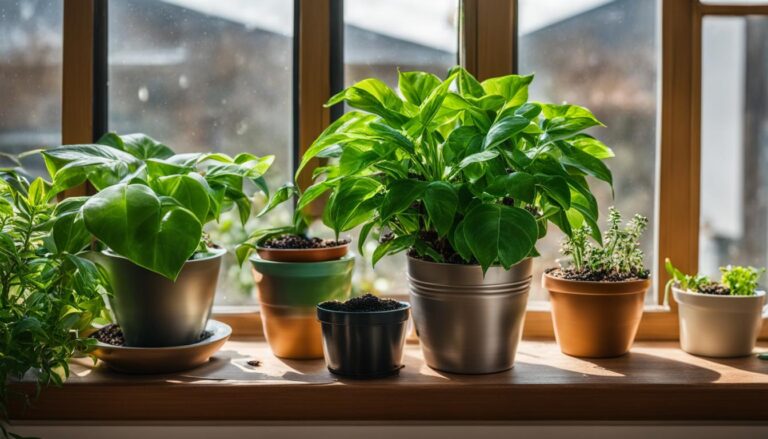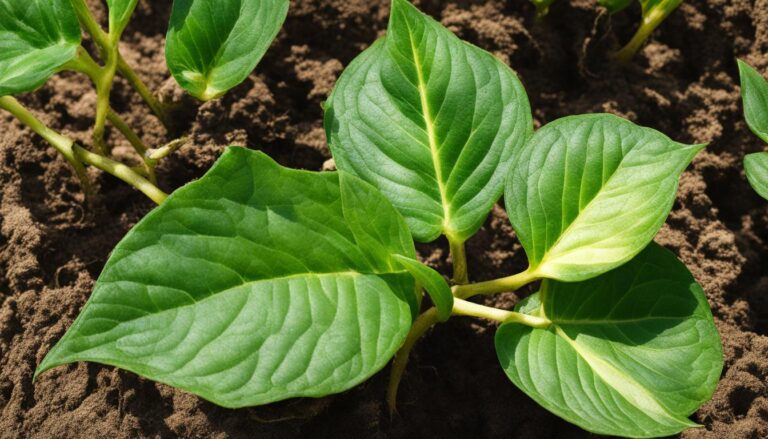
Potted plant care is essential for ensuring the well-being and vitality of your container plants. One crucial aspect of potted plant care is nurturing healthy root systems. Root development plays a crucial role in the overall growth and productivity of potted plants, making it essential to optimize root growth in container plants.
Container gardening root health relies on several key factors that contribute to the establishment and maintenance of healthy roots. These factors include soil composition, proper watering techniques, mulching, fertilizing, and pruning. By understanding and implementing these practices, you can promote robust and thriving root systems in your potted plants.
Key Takeaways:
- Healthy root systems are crucial for the well-being and productivity of potted plants.
- Factors such as soil composition, watering techniques, mulching, fertilizing, and pruning influence root growth in container plants.
- Improving soil quality by adding organic matter and enhancing drainage enhances root health.
- Proper watering techniques, including deep watering and avoiding overwatering, support healthy root development.
- Pruning aids in maintaining healthy root systems by improving air circulation and removing diseased or damaged branches.
Understanding Plant Roots and Their Importance
Plant roots play a vital role in the growth and development of potted plants. They serve as extensions of the stem and root system, providing support and anchorage to the plant. Additionally, roots are responsible for absorbing water, nutrients, and oxygen from the soil, essential for the plant’s survival and overall health.
A healthy root system is crucial for optimal plant growth. It enables efficient water and nutrient uptake, ensuring that plants have the resources they need to thrive. On the other hand, unhealthy or damaged roots can lead to stunted growth, decreased yields, and weak stems.
Understanding the importance of healthy roots is key to successful potted plant care. By paying close attention to root health, gardeners can ensure that their plants have the best chance of flourishing.
Regular monitoring, proper watering techniques, and providing optimal growing conditions are all essential for fostering a strong and robust root system.
By following these tips and focusing on improving soil quality in your potted plants, you can create a conducive environment for healthy root growth. Remember to add organic matter, improve soil aeration, and enhance drainage to ensure optimal plant health and productivity.
Proper Watering Techniques for Healthy Root Growth
Proper watering is essential for promoting healthy root growth in potted plants. The frequency and technique of watering play a significant role in ensuring optimal root health.
Watering Frequency
The frequency of watering depends on several factors, including the type of soil, plant species, and weather conditions. It’s crucial to strike a balance between providing enough water for the roots’ needs while avoiding waterlogging or underwatering.
One effective way to determine when plants need watering is to check the moisture level in the soil. Insert your finger about an inch into the soil and assess its moisture content. If it feels dry, it’s an indication that watering is required. However, if the soil feels damp, it’s best to wait before watering again.
Watering Techniques
When watering potted plants, it’s important to apply water at the right location and in the appropriate manner. Water should be applied from the top, allowing it to run through the soil and reach the roots. This encourages deep root growth and prevents the formation of shallow, surface-level roots that are more susceptible to drying out.
It’s crucial to water thoroughly, ensuring that the soil is evenly moistened. Avoid shallow watering, which can lead to uneven root growth and increased vulnerability to drought stress. Additionally, avoid over-watering, as this can lead to waterlogging and negatively impact root health.
Signs of Drought Stress
Understanding the signs of drought stress can help determine when watering is necessary. Common indicators include wilting leaves, dry and brittle foliage, and slow or stunted growth. If you notice these signs, it’s vital to water your potted plants promptly to prevent further damage.
Consistent watering at the same time each day helps establish a routine for your potted plants and ensures their water needs are consistently met.
By following proper watering techniques and paying attention to the signs of dehydration, you can foster healthy root growth in your potted plants and promote overall plant health.
Pruning and Maintaining Healthy Root Systems
Pruning is an important practice for promoting healthy root systems in potted plants. By removing diseased or damaged branches, we can improve air circulation around the roots, allowing them to breathe and thrive. Additionally, pruning helps provide light and nutrition to the roots, supporting their growth and development.
To ensure the health of the roots, it’s crucial to know the signs of both healthy and unhealthy roots. Healthy roots typically appear white or off-white in color, firm to the touch, and plentiful.
They usually exhibit a wound-up structure that mirrors the shape of the pot. These are strong indicators of a well-functioning root system.
On the other hand, signs of unhealthy roots can include various discolorations, such as brown, black, gray-brown, or reddish-brown. These colors often indicate the presence of root diseases, such as root rot or fungal infections.
Identifying and addressing these issues promptly can prevent further damage to the root system and ultimately protect the overall health and productivity of the plant.
By embracing pruning practices and paying close attention to the signs of healthy and unhealthy roots, we can maintain and optimize the root systems of our potted plants. This, in turn, will contribute to their overall vigor, resilience, and ability to absorb nutrients and water efficiently.
FAQ
How often should I water my potted plants?
Potted plants should be watered deeply and infrequently. The frequency of watering depends on factors such as soil type and weather conditions. Water should be applied from the top-down to encourage deep root growth. Signs of drought stress, such as reduced leaves and growth, indicate the need for watering. Watering should be done consistently and at the same time each day.
What are the signs of healthy roots in potted plants?
Healthy roots are usually white or off-white in color, firm, and numerous. They should have a wound-up structure similar to the shape of the pot.
How can I improve soil quality in my potted plants?
Adding organic matter, such as compost, can improve soil fertility and drainage. Turning the soil regularly can also help improve soil aeration. Proper drainage is essential to prevent excess water-logging, which can lead to root rot and other diseases.
What factors influence root growth in potted plants?
Several factors can influence root growth in potted plants, including soil composition, moisture availability, temperature, and light exposure.
Why is pruning important for maintaining healthy root systems?
Pruning can improve air circulation, provide light and nutrition to the roots, and remove diseased or damaged branches. Maintaining healthy roots is essential for overall plant health and productivity.






One Comment
Comments are closed.